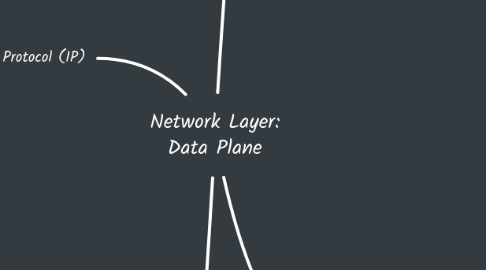
1. Internet Protocol (IP)
1.1. Datagram format
1.1.1. IP protocol version, length, service
1.1.2. Fragmentation/reassembly
1.1.3. Checksum, upper layer protocol, remaining hops
1.1.4. Source and destination IP, options
1.1.5. Payload data
1.2. Addressing
1.2.1. IP address
1.2.1.1. Host
1.2.1.1.1. Coded by sysadmin in config file
1.2.1.1.2. Dynamic Host Configuration Protocol (DHCP))
1.2.1.2. Network hierarchical addressing
1.2.1.2.1. Allocated portion of its ISP's address
1.2.1.2.2. ISP allocate its address space
1.2.1.2.3. Efficient advertisement of routing informations
1.2.2. Interface
1.2.3. Subnets
1.2.3.1. Inerfaces that can physically reach each other
1.2.3.2. Structured IP addresses
1.2.3.2.1. Subnet part (mask)
1.2.3.2.2. Host part
1.2.3.3. Divise in classi
1.2.3.3.1. A : 0 + Net_id 7 bit + Host_id 24 bit
1.2.3.3.2. B : 10 + Net_id 14 bit + Host_id 16 bit
1.2.3.3.3. C : 110 + Net_id 21 bit + Host_id 8 bit
1.2.3.3.4. D : 1110 + Multicast Address 28 bit
1.2.3.3.5. E : 1110 + Reserved 23 bit
1.2.3.3.6. Successivamente: 10 + Net_id + Subnet_id + Host_id
1.2.4. CIDR
1.2.4.1. Subnet portion of address of arbitrary length (Supernetting)
1.2.4.1.1. Impiego efficiente dello spazio di indirizzamento
1.2.4.1.2. Minore complessità delle tabelle di instradamento
1.2.4.1.3. Blocchi consecutivi di classe C
1.2.4.1.4. Ultimi 8 bit per l'host
1.2.4.2. Address format: a.b.c.d/x where x is the mask (bits in subnet portion)
1.3. Network address translation (NAT)
1.3.1. Devices in local network share one IPv4 address
1.3.1.1. One IP adress for all devices
1.3.1.2. Host can change address or ISP whitout affecting other devices
1.3.1.3. Devices not directly accessible and visible by outside
1.3.2. Datagrams leaving local network have same source NAT IP address but difference source port
1.3.3. Implementation
1.3.3.1. Outgoing datagrams
1.3.3.2. Remember every translation pair
1.3.3.3. Incoming datagrams
2. IP fragmentation/reassembly
2.1. Networks link have MTU
2.2. Large IP datagram divided
2.2.1. Reassembled at destionation
2.2.2. IP header bits identify and order related fragmens
3. Overview
3.1. Data plane
3.1.1. Local, per-router function
3.1.2. Forwarding: how arriving datagrams is forwarded
3.2. Control plane
3.2.1. Network-wide logic
3.2.2. Routing: determines how datagram is routed along end-end path
3.2.2.1. Traditional routing algorithms: interaction of each routing algorithm in every router
3.2.2.2. Software-defined networking (SDN): forwarding tables are installed by remote controller
3.3. Best-effort service
3.3.1. Simplicity of mechanism
3.3.2. Sufficient provisioning of bandwidth
3.3.3. Replicated, application-layer distributed services
3.3.4. Congestion control
4. What's inside a router
4.1. Routing, managment control pane (Software)
4.2. Forwarding data plane (Hardware)
4.2.1. Input ports
4.2.1.1. Line termination
4.2.1.2. Link layer protocol
4.2.1.3. Forwarding queueing
4.2.1.3.1. Using header field values, lookup output port using forwarding table
4.2.1.3.2. Input port queueing
4.2.2. Switching fabric
4.2.2.1. Memory
4.2.2.1.1. Switching under direct CPU control
4.2.2.1.2. Packet copied to memory
4.2.2.1.3. Speed limited by memory bandwidth
4.2.2.2. Bus
4.2.2.2.1. Shared bus for datagrams
4.2.2.2.2. Bus contention
4.2.2.3. Interconnection network
4.2.2.3.1. Interconnection nets to connect processors in multiprocessor
4.2.2.3.2. Multistage switch
4.2.2.3.3. Exploiting parallelism
4.2.3. Output ports
4.2.3.1. Buffer queueing
4.2.3.1.1. Buffering when link transmission rate slower then fabric
4.2.3.1.2. Drop policy
4.2.3.1.3. Scheduling discipline
4.2.3.2. Link layer protocol
4.2.3.3. Line termination
